Keeping Your Active and Engaged Sponsor on Track During Change
6 Mins
Updated: October 31, 2025
Published: March 22, 2023

As a change practitioner, your role is like the director of a play who enables performers on the stage to deliver a successful outcome. But when the performer is a busy executive in high demand for high-priority activities, how do you make sure your change initiative gets the time and attention it needs for success?
Your Busy Executive Sponsor of Change
What’s competing for your executive’s mindshare and energy during an organizational change? Over the course of a few hours, an executive may have an important customer conversation, review board meeting slides, conduct a phase-gate review on the product development pipeline, and work through an unexpected legal issue—all while maintaining their 4:30 p.m. coaching commitment to their daughter's hockey team.
You, on the other hand, must help the executive keep the ABCs of Sponsorship for your change top of mind. To be successful, you need to be thoughtful, strategic and patient—because your sponsor has significant impact on your change.
Prosci Research on Sponsor Impacts
Prosci research shows that having solid access to your sponsor correlates with meeting or exceeding objectives from change initiatives.
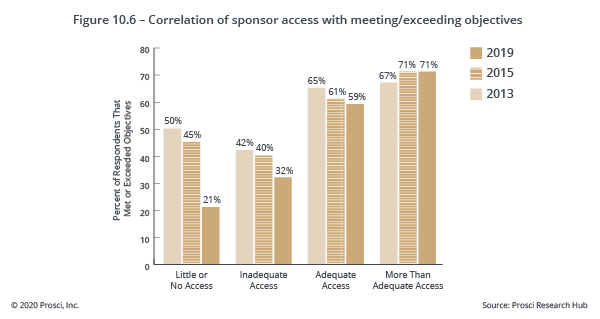
And change management effectiveness jumps from 33% to 72% for those with more than adequate access.
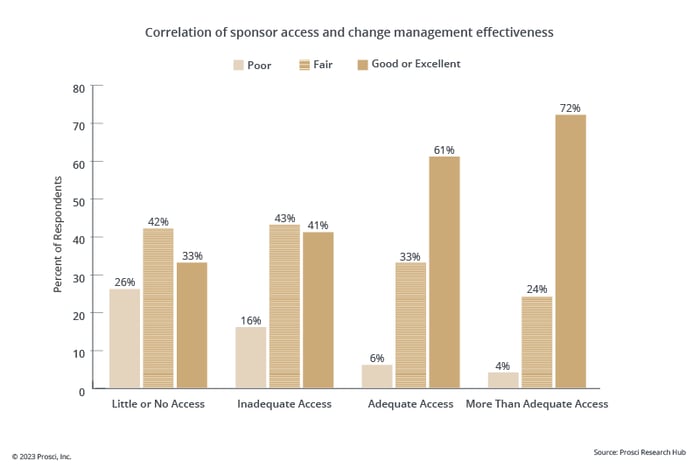 Yet, many change practitioners struggle with sponsors who lack time and resources to support the change or simply don’t understand their role well enough to be effective. In fact, research participants say the biggest mistake sponsors make is failing to remain active and visible throughout the life of the project. How can you make sure this doesn’t happen to your sponsor?
Yet, many change practitioners struggle with sponsors who lack time and resources to support the change or simply don’t understand their role well enough to be effective. In fact, research participants say the biggest mistake sponsors make is failing to remain active and visible throughout the life of the project. How can you make sure this doesn’t happen to your sponsor?
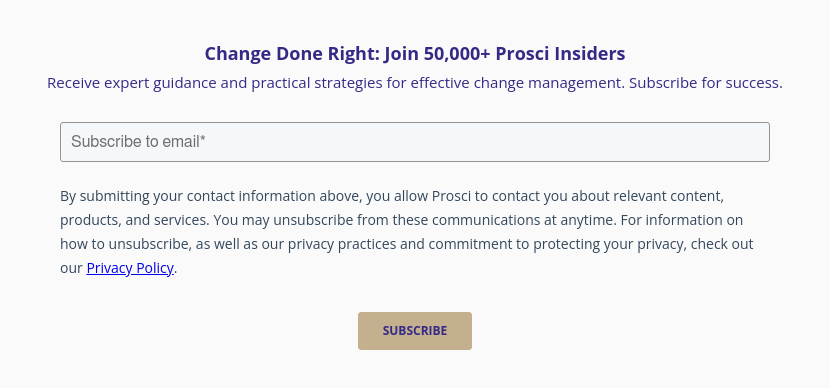
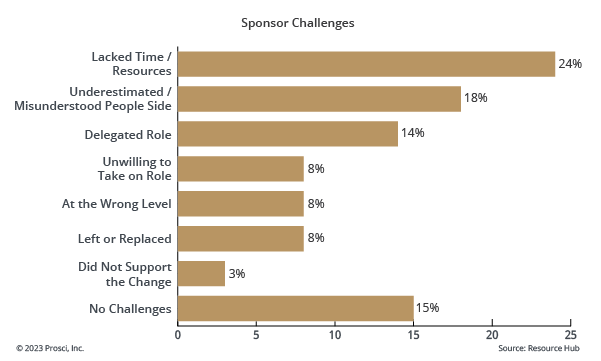
Help Your Sponsor of Change Stay on Track
Here are just a few of the key learnings and approaches I have relied on for nearly 30 years while working with executive sponsors, and now as one myself.
1. Design a clear agreement
As you engage in a change with a sponsor, it’s critical to get clear on roles and how you will work together. At the outset, I recommend scheduling a 30-minute role meeting to ask and discuss:
- What questions do you have about your sponsor role?
(Check for their understanding of the ABCs and reinforce anything they may have missed.) - What questions do you have about my role as the change manager on this project?
(Offer up the role headlines as needed.) - How would you like to work together on this change?
(Encourage your sponsor to share their expectations first.) - Will you attend project team meetings, or do you prefer separate sponsor meetings?
(Determine how hands-on they want to be.) - Do you have any specific role expectations we have not discussed?
I also ask sponsors for explicit permission to speak candidly with them about the change (i.e., speaking truth to power). This is a personal favorite agreement for me. Without candid discussions, it can be difficult to move changes forward.
The Prosci Change Triangle (PCT) Model is a great visual reference to support your discussion. Keep it to a single page while offering a high-level overview.
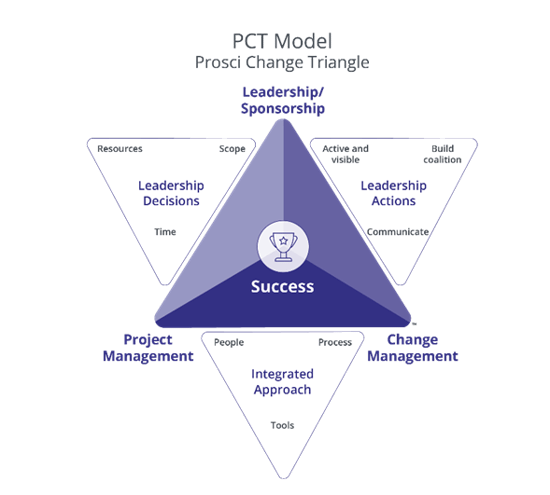
Next, talk to your sponsor to find out how they work best. What’s their “partnering persona” (as described in #2 below) on initiatives like this? During this interview, ask questions that help them understand their role, confirm the business reasons for the change, and connect with their personal WIIFM (What’s in it for me?):
- Why is this change important to you?
- How will you keep this change on the priority list, and what will compete with it?
- Is this change part of your business or personal goals?
- How does this change impact the organization’s top line or bottom line?
If you can’t ask the sponsor all these questions, consider asking those around them for additional perspective.
To wrap up the meeting, confirm where you stand and how you will move forward together. You might say something like, “Great, I know your role and I am clear on mine. Let’s meet every other week for 30 minutes, so we can stay connected on what’s most important.” Or you might say, “Expect an email from me each Monday morning with your key actions and messages.” If you’ve listened and designed your agreements well, you will hit the mark. And you can always adjust later as needed.
2. Get to know your sponsor’s partnering persona
In my experience, sponsors like to work with change practitioners one of three ways. You can think of these as “I Do,” “We Do,” and “You Do” personas.
I Do
This sponsor needs little guidance and coaching on change management sponsorship. They are well-versed in the change, and their talk track is solid. Critical meetings are already on their calendar, they’re executing the right actions, and they’re delivering the right messages. This sponsor may even be a natural at asking how the change is going, collecting real-time feedback from impacted groups, and more.
We Do
This sponsor wants you alongside of them as a coach and confidant throughout a change. In addition to equipping them with tools and instructions, they may want talking points, frequent meetings for reflection, and your insights as a change practitioner.
You Do
This sponsor prefers for you to do some heavy lifting behind the scenes. Don’t confuse this with being an inadequate sponsor. They simply want you to be more prescriptive about how, where and when they show up. That said, you must walk the line with this sponsor and actively coach them into executing the ABCs of Sponsorship effectively. Otherwise, you risk over functioning by replacing them or being called into the role as a proxy.
Of course, every sponsor is unique. What else about their persona do you need to know? Do they like things written down on paper, in an email, on a slide, or to just have a conversation? Are they highly structured, or do they like informal chats? The better you understand them, the better you will be at enabling your sponsor for their role.

3. Enable sponsor actions
Executive calendars get planned out far ahead and change on a moment’s notice. You need to be prepared for both. Thinking ahead—at least one month—makes planning and scheduling sponsor activities less stressful.
Start by removing roadblocks. Although you shouldn’t do their sponsor job, making tasks as easy as possible ensures they will get done. To accomplish this, create your Sponsor Plan and break it down into sprints. Share a concise list of must-do items, ideally one or two items per week (or based on the pace of the project plan and key ADKAR milestones). Work with your sponsor and their team to integrate these items into their calendar, task system or inbox. You could also create a one-page roadmap for them to follow, complete with key asks, moments, messages and actions.
To tailor actions for your unique sponsor, ask:
- How do you want to show up on this change with your peers?
- What will you share at executive team meetings?
- How can I best prepare you?
Be ready for every meeting in advance with one-pagers or short to-do lists. And always close the loop on tasks they assign to you by following up.
4. Develop the right sponsor coaching behaviors
Coaching a sponsor effectively takes practice. It’s a balance of leading, supporting and questioning as the change management plan unfolds. I always start sponsor check-in sessions by stating what I would like to achieve and asking if there is anything else they need or want (i.e., a decision or action, input or awareness). I typically put my agenda out first to ensure they know I am here to keep them on track, but I am always willing to put my agenda second if they need to discuss more pressing matters.
When solutioning, you can certainly suggest options for consideration, e.g., “You could do this or that or this.” But asking the right questions will help sponsors arrive at an answer themselves. Alternatively, you should ask questions that prompt them to consider the solutions only available to them given their role in the business, for example:
- What is the best meeting for you to speak at about this?
- How can you bring this stakeholder into the solution?
- What might be the best approach for creating Awareness and Desire with the executive team?
- Are there any other business conditions that could enable or stall our progress?

By now, it should be clear that being curious is an important part of coaching. Ask your sponsor what they’re hearing or what feedback they’re receiving from their meetings, engagements and peers. Get the executive perspective on what’s working and what’s not. Of course, you must respect boundaries. You can assume that some topics are confidential, and you may not be privy to all of them.
Coaching a sponsor on corrective actions is sometimes a delicate dance. Your role is to guide the sponsor’s performance on the organizational stage, not dictate it. Unless you have permission and established trust, you may not want to call out gaps in sponsor effectiveness directly. Instead, try weaving corrective actions into forward-looking advice and coaching conversations.
For example, imagine that the sponsor was not at the top of their game communicating key messages at a recent event. When giving feedback, don’t just tell them they messed up. Instead, look for opportunities to share words they might use instead of those they chose. When discussing the next speaking task, you could say, “Let’s emphasize this point even more next time.” Or “Let’s follow up with this stakeholder group because I am not sure they were convinced that you heard them.” Another great tip is to ask them how they think it went, and then coach from there.
As a change practitioner, you will also need to be courageous at times. Remind your sponsor of your agreement to speak truth to them and tell them what they need to know, even when they may not want to hear it. Always bring the facts and try to minimize the stories. Being courageous includes asking your sponsor for feedback on your performance too. Is there is anything you could have done better? Did they have what they needed to be successful?
Change Management Sponsorship and Relationship Building
Building a relationship with your executive sponsor ensures the trust and access you need to best serve the change initiative you’re driving. Think like a leader. Have empathy for them and their responsibilities. Remember that this is not the only change going on. Executive sponsors are human and imperfect (just like the rest of us), and essential to your success with any change. The effort you make to build the right capabilities together will yield rewards for you, your sponsor, and your entire organization.




